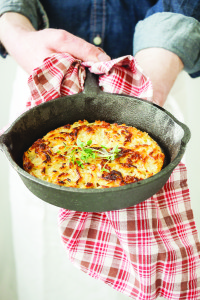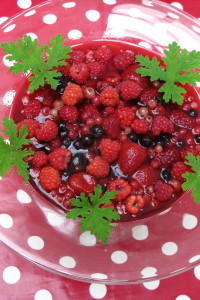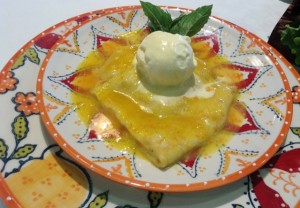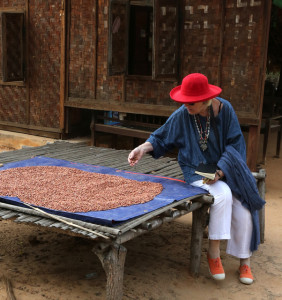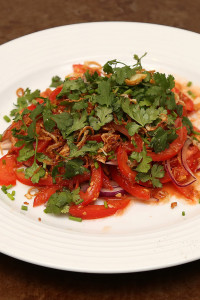Tamil Nadu in South India particularly the Chettinad area is a ‘road much less travelled’ than many of the trendier tourist destinations like Goa, Rajasthan and Kerala but intriguing, particularly for those who have a penchant for temples, architecture and of course food. I’m interested in all three but I have to say one can easily get ‘templed out’ in many parts of India.  Chettinad is particularly fascinating from the architecture perspective.
In the 1990’s, pioneering lady Meenakshi Meyyappan from one of the most prominent Chettinar family was the first person to open one of her houses as a delightful heritage hotel. Just 4 simple rooms at first and a welcome as though one was a guest of the family. She served the fresh food of the Chettinad homes where everything was not just prepared and cooked ‘from scratch’ but grown in the gardens or produced on the family farm.
Since my last visit in 2011 the Bangala has expanded to 21 rooms, there’s a swimming pool and a cookery school where Meenaskshi chefs can pass on the secrets of the much requested Bangala recipes. Freshly squeezed juices, watermelon or pineapple or dosa or breakfast with idli and sambar, rice…if that all seems too challenging there were of course masala omelettes and pancakes but for me lunch was the most exacting meal of the day, a wide variety of dishes served on a banana leaf in the traditional way. Rice of course, then both a fish and meat dish, several vegetarian curry and stews fritters, a raita, several chutneys and a poppadums. The selection was different every day, cutlery is provided but one is encouraged to eat with one’s hands in the elegant Indian way. Dinner is a multi-ethnic affair with a mixture of Asian and Anglo Indian dishes but I don’t go to India for bread and butter pudding or crème caramel, no matter how delicious…..
The Bangala is heart of Karaikudi so one can comfortably wander around the colourful vegetable and fruit market and bazaar and the antique area, best in the early morning or evening when the temperature has dropped to the mid-twenties. The hardware and household utensil shops are also intriguing and I love the simple little tea shops where people congregate in the evenings to have a glass of a chai and a snack. I had some delicious plantain fritters  cooked in a lentil batter with a fresh coconut chutney served a square of banana leaf – for just 50 rupees.
Not everyone’s idea of ‘chilling out’ but I love to attend cooking classes when I’m on holidays to vamp up on the local food culture and ingredients and learn a few new dishes to pass on to my readers and students.
Here’s some of what I learned from Karuppiali, Chef at The Bangala, the ingredients are easy to find and techniques familiar to those who have already discovered the magic of spices.
Hot Tips
Green Saffron Pops Up in Paris
Arun Kapil from Green Saffron in Midleton is hosting a three week Green Saffron Pop UP in Paris from April 26th to May 14th 2016 in Alcazar restaurant in St Germain des Près.. Arun has created a spicy menu to entice the French people to enjoy spicier food and drinks.
Tel:Â 021 463 7960 or www.greensaffron.com
Â
Don’t forget to place an order for Spring Lamb from your butcher for Easter Sunday lunch – it’s a special treat so not available everywhere
Check out the Examiner website for the Ballymaloe Hot Cross Bun recipe
Â
Date for the Diary
Pop-Ups Everywhere!
Michelle Darmody from The Cake Café in Dublin is hosting a Pop Up Café in The Projects Arts Centre in Temple Bar in Dublin in an effort to highlight the fact that asylum seekers living in direct provision are not able to cook for themselves. Don’t miss the two day Pop Up restaurant, on 5th and 6th April 2016 from 12pm-3pm where the menu will be devised and cooked by those in direct provision. Proceeds will go to the Refugee Council of Ireland
Tickets €15.00. Booking Essential. Phone Michelle Darmody 087 938 4455 for more details.
Good Things Cafe
Carmel Somers’s many fans will be delighted to hear that Good Things at Dillon’s Corner in Skibbereen is now up and running. Carmel is a beautiful cook who uses fresh, seasonal, organic ingredients to create delicious food for her growing number of devotees. For reservations Tel: 028 51948 or www.thegoodthingscafe.com
Recipes
Potato Karuvattu Poriyal
Don’t let this unprouncable title or long list of ingredients put you off trying this recipe – it was totally delicious.
Serves 4
Â
Wet Paste
1½ teaspoons cumin seeds
1 teaspoon fennel seeds
2 fresh green chillies
â…“ cup grated coconut
400 g (14 oz) potatoes, peeled, cut into wedges like potato chips
2 teaspoons salt
¼ cup vegetable oil
1 teaspoon black mustard seeds
1 teaspoon urad dal, hulled split
½ teaspoon fennel seeds
50g (4 oz) onion, peeled and finely chopped
1 teaspoon garlic paste
½ heaping teaspoon ginger paste
10 curry leaves
1½ teaspoons red chilli powder, mild
½ teaspoon turmeric powder
¾ teaspoon salt
1 tablespoon fresh coriander leaves, chopped
Grind cumin seeds, fennel seeds, green chillies and coconut in a blender with some water to make a wet paste. Set aside.
Pour enough water into a saucepan to cover the potatoes and bring to a boil over a medium heat. Slide in the potatoes and 2 teaspoons of salt. Let them boil, covered, till fork tender, 7-10 minutes. Drain in a colander and set aside.
Add oil to a wok over a medium –high heat. When the oil is hot but not yet smoking, slide in the mustard seeds. Once the mustard seeds start to crackle, add the urad dal and stir. Add the fennel seeds and onion, and sauté for 1 minute.
Add garlic and ginger followed by curry leaves, chilli powder and turmeric. Stir before adding the reserved wet paste. Continue to stir constantly.
When the oil has separated from the masala and the mixtures looks cooked, sprinkle with salt and then add the drained pototaes, mixing well. Sauté for 2-4 minutes, scraping the bottom of the pan to incorporate all the carmaelized bits of masala. Serve hot garnished with coriander leaves.
From The Bangala Table Flavours and Recipes from Chettinad, Sumeet Nair, Meenakshi Meyyappan with Jill Donenfeld
Brussel Sprouts Masala Poriyal
Most of our international guests at The Bangala enjoy this masala poriyal. They are familiar with Brussel sprouts and like the masala presentation.
250 g (9 oz) brussel sprouts, cut in quarters if large
½ teaspoon salt
50 ml (2 fl oz/¼ cup) vegetable oil
100g (3½ oz) onion, peeled and finely chopped
½ teaspoon ginger paste
1 teaspoon garlic paste
½ teaspoon turmeric powder
2 teaspoons red chilli powder, mild preferably made from goondu milagai
½ cup fresh tomato puree
½ teaspoon salt, or to taste
1 tablespoon fresh coriander leaves, chopped
Pour 2 cups of water into a saucepan and bring to a boil over medium heat. Slide in the brussel sprouts and ½ teaspoon salt and bring back to a boil. Reduce heat to low and simmer, covered, till tender. Drain in a colander and set aside.
Add oil to a large wok over a high heat. When the oil is hot but not smoking, slide in the onion and sauté for 1-2 minutes. Follow by adding the ginger and garlic paste, turmeric and chilli powder. Stir once and add tomato puree and ½ teaspoon salt. Continue to cook, reducing the heat to low, stirring and scraping to ensure that nothing sticks to the bottom.
When the oil separates from the masala, add the drained Brussel sprouts to incorporate. Stir for 1-2 minutes, scraping the bottom of the wok. Remove from the heat, garnish with coriander leaves and serve.
The Bangala Table Flavours and Recipes from Chettinad, Sumeet Nair, Meenakshi Neyyappan with Jill Donenfeld
Raisin and Cashew Nut Pulao
An aromatic pulao with flavours of whole spices, dry fruit and coconut milk. This is serves as‘main rice’ for dinner at The Bangala. Cooking the rice in coconut milk instead of just water adds depth and a lovely, flavourful creaminess to this dish.
Serves 4
300 g (11 oz/1½ cups) basmati rice
125 ml (4 fl oz/ ½ cup) vegetable oil
3 green cardamom pods
Once 3- inch piece cinnamon, broken in half
13 cloves
3 fresh green chillies slit at the base
60 g (2½ oz) onion, peeled and finely chopped
10 unsalted cashew nuts, broken
1½ tablespoons raisins
1½ teaspoons sea salt or to taste
350 ml (12 fl oz/1½ cups) thin coconut milk
¾ cup thick coconut milk
Place rice in a bowl and wash under running water, gently stirring and mixing the rice with your hands, draining each time the bowl fills up. Do this 2 or 3 times, till the water runs clear; then let soak in fresh water, covered for at least 30 minutes. Drain.
Pour oil into a large saucepan over high heat. When hot, add cardamom and cinnamon. Once the cardamoms have plumped up nicely, about 30 seconds add cloves and green chillies and stir. Next, slide onion into the pan and sauté till translucent, about 1 minute, before adding the cashew nuts and raisins.
Pour in 1½ cups water, salt and the thin coconut milk, mix to incorporate and cover to let simmer for 2 minutes before turning the heat to high. Add rice, stir and wait for it to come to the boil before reducing the heat. Let it cook, covered for about 10 minutes before adding the thick coconut milk. Simmer for 15-20 minutes or until the rice is cooked and liquid is absorbed. Grains should be separate and not too soft. Check seasoning. serve hot.
The Bangala Table Flavours and Recipes from Chettinad, Sumeet Nair, Meenakshi Neyyappan with Jill Donenfeld

